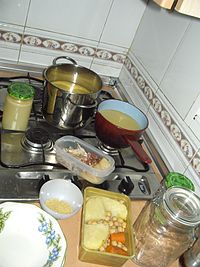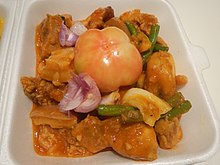Puchero
This articleneeds additional citations forverification.(March 2011) |
 | |
| Course | Main course |
|---|---|
| Place of origin | Spain |
| Main ingredients | Varies by region |
Pucherois a type ofsteworiginally from Spain, prepared inYucatán, Mexico,Argentina,[1]Paraguay, Uruguay, Perú, south of Brazil, the Philippines, and Spain, specifically theautonomous communitiesofAndalusiaand theCanary Islands.The Spanish word "puchero"originally meant an earthenware pot, before being extended to mean any vessel, and then the dish cooked in it.[2]
The dish is essentially equivalent to thecocidoof Spain but lacks colorants (such as paprika) and uses local ingredients which vary from one region to another. In Spain,chickpeasare widely used. Puchero, cocido, and thesancochoeaten in Colombia, Ecuador, República Dominicana, Venezuela, and Puerto Rico are essentially similar dishes.
Andalusian puchero
[edit]In Andalusia,pucherowas originally a peasant soup. The basic ingredients of the broth are meat (beef,veal,porkorchicken),bacon,cured bones (such as those of thejamón serrano), and vegetables (potatoes,celery,chard,leek,carrots,andturnips). It can be drunk straight in mugs as aconsomméknown ascaldo de puchero,which can be seasoned with freshspearmintleaves orsherry.Alternatively, it can be prepared as a soup after addingchickpeas,cured ham,boiled egg,andrice,noodlesorbread.The meats, calledpringá,are usually served separately as a main dish, and the remnants used for subsequent dishes ascroquettesorropa vieja.
Río de la Plata puchero
[edit]
Puchero is eaten in the parts of Argentina, Uruguay, and Paraguay that border the Río de la Plata. The dish is prepared in the same way as in Spain, though its ingredients differ according to the very different local produce. In the parts of Argentina, Paraguay and Uruguay surrounding theestuaryof theRío de la Plata,puchero is primarily beef-based—beef was plentiful and cheap—and chickpeas are less commonly used than in theIberian Peninsula.The broth and the solid ingredients are often consumed separately.
The cuts of meat used are particularly important: if possible,ossobuco;otherwise beef cuts withmarrowor poultry (used inpuchero de gallina) can be substituted. Other ingredients used may include potatoes,onions,andsquash.Typical local produce used includessweet potatoes,[1]moderately fatty pork cuts,sweet corn,carrots,pork bellyor cabbage.
Puchero is traditionally served during the colder months. It is not considered fine dining, and can be found on menus in family and regional restaurants throughout Argentina, but not at most more expensive restaurants.[1]
Philippine puchero
[edit]
InPhilippine cuisine,puchero (Spanish:Pochero;Tagalog:putsero) is a dish composed of beef chunks stewed withsababananas(or plantains). The dish may also include potatoes or sweet potatoes,chorizos de Bilbao,bok choy,leeks, chickpeas, cabbage and tomato sauce. Other versions replace beef with chicken or pork.
Chicken Pochero is a "One-PotMeal. "It is cooked with combination of minced red onion and cloves garlic, diced large tomatoes, sweet potatoes and chicken, slicedchorizo de Bilbaoandbok choy,tomato sauce, water,seasoning,ground black pepper, halved cabbage,green bean,greenpeas,soy sauce andpatís.[3]
Yucatec puchero
[edit]The Yucatec puchero varies by cook and region. The most complete version is called puchero de tres carnes— "with three meats", pork, beef and chicken. Other ingredients may include a piece of plantain in skin, onion, potatoes, sweet potatoes, carrots, squash (calabaza), turnips or parsnips, white cabbage (repollo) and typically a type of pasta soup (noodles,fideos) and rice to increase the heartiness and especially if only one or two meats are used. The soup like the 98% of Yucatec soups-stews are broth consommés, not at all thick or heavy. It is flavored with saffron, allspice and black pepper. The dish is served with all ingredients in the bowl and a side of fresh additions. Typically or traditionally, a side plate is provided so that the person can put the meat to the side while eating the soup. The garnish consists of freshly chopped or dicedhabanero chili,onion, radish and cilantro. Avocados when in season. See Steffan Igor Ayora Diaz book on the anthropology of Yucatán food[4]
See also
[edit]
- Andalusian cuisine
- Argentine cuisine
- Canarian cuisine
- Colombian cuisine
- List of stews
- Philippine cuisine
- Uruguayan cuisine
References
[edit]- ^abc"Sabores argentinos: el puchero"(in Spanish). April 20, 2010. Archived fromthe originalon April 29, 2012.Retrieved2011-03-07.
- ^Real Academia Española (2019)."puchero".Diccionario de la lengua española(in Spanish).
- ^Dy-Zulueta, Dolly (January 10, 2024)."Chef Tatung Sarthou shares 'Pochero' recipe from 'Simpol Dishkarte' book".The Philippine Star.RetrievedJuly 13,2024.
- ^Ayora-Diaz, Steffan Igor (2012) Foodscapes, Foodfields and Identities in Yucatán. Amsterdam: CEDLA, New York: Berghahn

